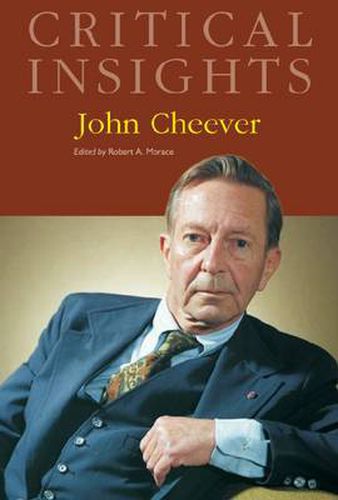Readings Newsletter
Become a Readings Member to make your shopping experience even easier.
Sign in or sign up for free!
You’re not far away from qualifying for FREE standard shipping within Australia
You’ve qualified for FREE standard shipping within Australia
The cart is loading…






This collection provides broad coverage of Cheever and his work. Original essays discuss the basic facts of Cheever’s life and critical reputation. The work explores his complicated personal life and discusses his decorous style and fragmented structure, and his fascination with language.
This Critical Insights volume opens with essays that provide the basic facts of Cheever’s life and critical reputation. Providing these facts is especially important in the case of the biography of a man who was prone to self-mythologizing. What’s more, Cheever’s version of his own life was long accepted as fact but, posthumously, has been complicated by unflattering revelations about his personal life in his daughter’s memoirs, in his published journals and in two biographies.
Establishing the basic facts of Cheever’s critical reception is equally important and differently challenging. The critical response to his writing was a roller-coaster ride. Reviewers and critics consistently failed to reach a consensus on Cheever’s importance.
Suburbia is central to any analysis of Cheever. Here he is discussed as a suburban romancer rather than, as was more usually the case, a novelist of manners. Mixed with self-doubt, this approach
may begin with allegorical ambitions but … then morphs into such tortuous interconnections, where superficial differences … become virtually synonymous with one another so that they are so entangled, one cannot decide where one ends and the other begins.
Cheever is described as
an unfailingly surreal lyricist of disorientation … whose fictions are propelled by fear
and who used imagination to mediate
between senseless reality and an immensely coherent dreamworld.
Cheever’s
wariness
toward modern life is treated in two essays that survey Cheever’s entire career. In
Supermarket and Superhighway,
these two dominant symbols are representative of the
nomadism and commercialism
that characterise
the modern malaise.
Another essay takes a similarly expansive look at Cheever’s career (through Falconer) but reaches a very different conclusion.
Cheever’s subject has been the increasing alienation of modern man from a central role in his own life to that of a peripheral, almost ignored spectator to a social process that has little real need of any individuals, requiring merely a mass.
Cheever depicted the suburbs as
a forceful yoking together of impossible contraries.
In Cheever’s much maligned third novel, Bullet Park, the
wry moral censure of the banal suburban existence
that is so evident in Cheever’s short fiction is given the space needed to pursue
dimensions of human dejection not completely accessible to the shorter form.
Putting Cheever’s suburban fiction in historical context, in another essay the writer examines the cultural significance of the suburbs in the 50’s and 60’s, plus the sociological and fictional responses to the suburbanisation of American life. In this context, it is noted that Cheever treats his white suburban readers as if they were
everyone.
$9.00 standard shipping within Australia
FREE standard shipping within Australia for orders over $100.00
Express & International shipping calculated at checkout
This collection provides broad coverage of Cheever and his work. Original essays discuss the basic facts of Cheever’s life and critical reputation. The work explores his complicated personal life and discusses his decorous style and fragmented structure, and his fascination with language.
This Critical Insights volume opens with essays that provide the basic facts of Cheever’s life and critical reputation. Providing these facts is especially important in the case of the biography of a man who was prone to self-mythologizing. What’s more, Cheever’s version of his own life was long accepted as fact but, posthumously, has been complicated by unflattering revelations about his personal life in his daughter’s memoirs, in his published journals and in two biographies.
Establishing the basic facts of Cheever’s critical reception is equally important and differently challenging. The critical response to his writing was a roller-coaster ride. Reviewers and critics consistently failed to reach a consensus on Cheever’s importance.
Suburbia is central to any analysis of Cheever. Here he is discussed as a suburban romancer rather than, as was more usually the case, a novelist of manners. Mixed with self-doubt, this approach
may begin with allegorical ambitions but … then morphs into such tortuous interconnections, where superficial differences … become virtually synonymous with one another so that they are so entangled, one cannot decide where one ends and the other begins.
Cheever is described as
an unfailingly surreal lyricist of disorientation … whose fictions are propelled by fear
and who used imagination to mediate
between senseless reality and an immensely coherent dreamworld.
Cheever’s
wariness
toward modern life is treated in two essays that survey Cheever’s entire career. In
Supermarket and Superhighway,
these two dominant symbols are representative of the
nomadism and commercialism
that characterise
the modern malaise.
Another essay takes a similarly expansive look at Cheever’s career (through Falconer) but reaches a very different conclusion.
Cheever’s subject has been the increasing alienation of modern man from a central role in his own life to that of a peripheral, almost ignored spectator to a social process that has little real need of any individuals, requiring merely a mass.
Cheever depicted the suburbs as
a forceful yoking together of impossible contraries.
In Cheever’s much maligned third novel, Bullet Park, the
wry moral censure of the banal suburban existence
that is so evident in Cheever’s short fiction is given the space needed to pursue
dimensions of human dejection not completely accessible to the shorter form.
Putting Cheever’s suburban fiction in historical context, in another essay the writer examines the cultural significance of the suburbs in the 50’s and 60’s, plus the sociological and fictional responses to the suburbanisation of American life. In this context, it is noted that Cheever treats his white suburban readers as if they were
everyone.